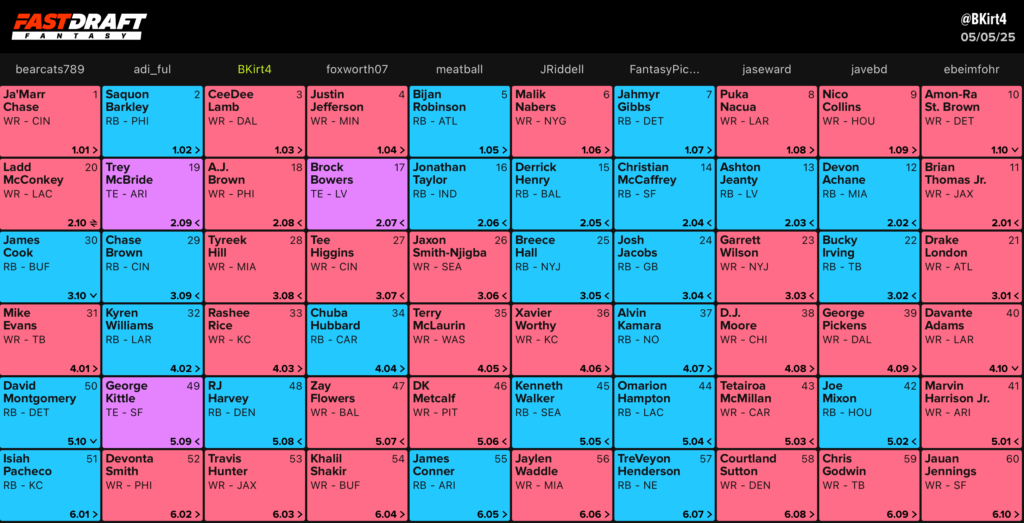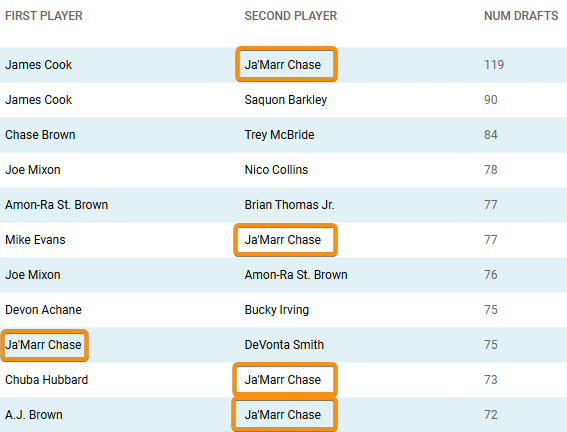When diving into a FastDraft Flex 4 Draft, the true magic lies in the unexpected pairings and bold combinations that emerge. Whether it’s a sleeper pick seamlessly complementing a veteran powerhouse or an unconventional strategy that flips the script, these drafts are where creativity meets competition. In this review, we’ll break down the most intriguing duos and dynamic formations that make this low-cost, high-reward format an exciting playground for fantasy drafters.
Let’s review a draft board to use as an example, in this article I’ll reference my team, and three other teams (JRiddell, jaseward and ebeimfohr). The data I’ll be referencing is current as of today 5/20/2025, the Flex $5 contest is 34.2% full or 3,420 teams have been drafted of the 10,000 total. This draft occurred on 5/5/2025 before the NFL Schedule was released.
Draft Review

BKirt4: Lamb-Brown-Hill-Rice-Harvey-Hunter
Leveraging the Spike Week TournamentDB tool, we can dive into the nuances of combinatorial ownership. This image highlights teams that have selected CeeDee Lamb, revealing a rare pairing—only 16 teams have drafted both CeeDee Lamb and A.J. Brown. This scarcity underscores the uniqueness of this combination.

When we then look at those specific 16 teams with CeeDee Lamb + A.J. Brown, we see that my team is the only one with Tyreek Hill on it. In a cumulative scoring tournament to have found a unique combo with your first three rounds of picks (while drafting reasonably) is a great feat. Reviewing the image, we see multiple other uncommon but reasonable options that are enticing. This is one of the reasons that I am interested in this contest, its relatively small in nature compared to other cumulative scoring best ball tournaments out there and we can use the Spike Week tools in a way to attempt to find an advantage.

- Top 2 Combo: 16 teams (5%)
- Top 3 Combo: 1 team (6% of Lamb-Brown teams include Hill)
- Last 2 Combo: 6 Teams
- Product Ownership: 100% x 100% x 100% x 100% x 36% x 31% = 11%
- Bye Weeks: 4
Product Ownership is a way during the draft we can simply and efficiently try to build a unique lineup. To figure out how rare or common a group of products is, you multiply the chances of owning each one. First, turn percentages into decimals (like 36% becomes 0.36). Then, multiply them all together, and convert the result back into a percentage. This helps analyze patterns and understand how often certain product combinations might appear in a large enough sample size. Does a higher product ownership mean a team is automatically worse? Absolutely not, the players still need to score the most fantasy points in a layered fashion. I’m merely suggesting it as a tie-breaker for players within a tier of your ranks.
Why did you consider Bye Weeks? Ideally, you want no more than zero to two players on bye in any given week, with a strong preference for just zero or one. This means I want at least four separate bye weeks for my six players. I’ll be actively managing for that, knowing injuries are inevitable and a little cushion goes a long way. The last thing I want is to enter a week unable to field a full starting lineup. Avoiding stacking from the same team can also naturally help spread out bye weeks. We’ll see a team a bit lower who had unfortunate bye luck and has four players on the same bye week.
JRiddell: Nabers-Henry-Hall-Worthy-Walker-Waddle
- Top 2 Combo: 20 teams (6%)
- Top 3 Combo: 3 teams (15% of Nabers-Henry teams)
- Last 2 Combo: 8 Teams
- Product Ownership: 100% x 100% x 100% x 100% x 100% x 19% = 19%
- Bye Weeks: 6
JRiddell had exclusively drafted players drafted 100% of the time until Round 6, they knew what to do. Time to scroll down and get a low owned player like Jaylen Waddle to drop that product ownership. They also ended up with the best bye luck of the lot.
jaseward: Nacua-Jeanty-Wilson-Moore-McMillian-Sutton
- Top 2 Combo: 41 teams (12%)
- Top 3 Combo: 3 teams (7% of Nacua-Jeanty teams)
- Last 2 Combo: 4 Teams
- Product Ownership: 100% x 100% x 100% x 100% x 88% x 16% = 14%
- Bye Weeks: 4
The team jaseward drafted had a high density Top 2 Combo, but they used Garrett Wilson as a way to cut down to only three teams having the same Top 3 Combo. They also paired two players in the last rounds together that haven’t been a common combination.
ebeimfohr: St. Brown-Thomas Jr.-London-Adams-Harrison Jr.-Jennings
- Top 2 Combo: 77 teams (23%)
- Top 3 Combo: 13 teams (17% of St. Brown-Thomas Jr teams)
- Last 2 Combo: 7 Teams
- Product Ownership: 100% x 100% x 100% x 85% x 99% x 16% = 13%
- Bye Weeks: 3
This team has four players with a Week 8 bye, to help offset this if I was Erik, I’d likely modify my captain boosters to prop up one or both of the players playing in Week 8. We can see that Erik had the chalkiest combo’s through rounds 2 and 3 but pulled the lever of players not always drafted through round 4-6 to help lower product ownership.
Common Combos
I do also want to mention a new tool that is available for FastDraft in TournamentDB that fits well with this Draft Review article and it’s called Common Combos. You can view the most common combos all up or even filter to specific players. Here’s a peek at the Top 11 combos drafted so far, five of them include Ja’Marr Chase. If you draft any of these Ja’Marr combos for instance, you’ll want to make sure to pull levers elsewhere when creating your lineup.

Conclusion
In bestball, success isn’t just about drafting projected top-tier players—it’s about constructing lineups with unique combinations that maximize tournament-winning potential. The key is to identify undervalued pairings and integrate high-upside players who can deliver breakout performances. By building distinct teams with well-calibrated risk and reward, drafters increase their chances of standing out in large-field competitions, where differentiation can be the deciding factor between merely competing and outright winning.




